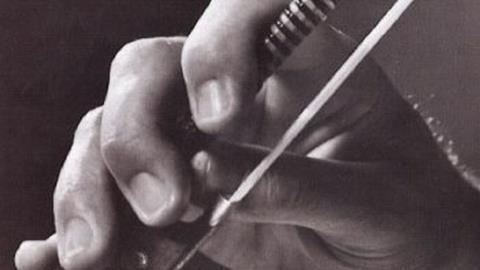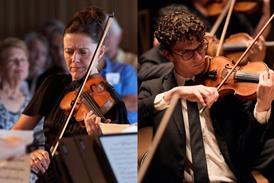Awareness of the movement of each right-hand finger is one of the great secrets of bowing, writes Rok Klopčič

Explore more Technique like this in The Strad Playing Hub
There are at least two different concepts of bow hold in the violin literature. One belongs to Galamian, who wrote that it is ‘based on a system of springs’; and the other is that of Percival Hodgson, who considered the ‘arm as a system of levers’. The two concepts are, in fact, complementary.
These two functions are clearly divided in the fingers of the right hand. Around the stick they form levers which move the bow in different directions, but individually they perform the role of springs. They are the last contact point between the whole bowing system and the stick, so their importance is very great.
Pedagogues have invented and recommended different exercises for attaining the most appropriate condition of the right-hand fingers: refined elasticity. This is what Harold Berkley describes as ‘a springy, almost spongy, feeling’, which helps to get the best ‘quality of pressure’, according to Galamian.
However, most of these exercises involve the fingers acting as a whole. Very rarely do we come across descriptions of the role of different fingers, while examinations of motions which cannot be seen – the micro-motions of individual fingers on the stick – are even more rare.
Here Lucien Capet, very much alone, is precise in his observations. In his work 'La technique supérieure de l’archet' he emphasises that ‘independent control of the fingers on the stick is to be preferred to the simple control of the whole hand bearing with the full weight on the bow in one direction only.’
Read: Technique: Teaching collé
Read: How I warm up: violist Maxim Rysanov
Read more Technique like this in The Strad Playing Hub
Capet treats the third finger with extraordinary attention. He calls it the ‘spiritual guide’ as far as ‘general sensibility of the fingers on the stick is concerned’. He suggests that ‘with its subtle presence it makes all elements perfect’ and ‘augments the sweetness, strength, sensitivity and decision’ of the bowing arm, summarising that the ‘superior or interior life of the bow is conditioned by different pressures of the fingers in different directions.’
The connection between different micro-movements of the fingers of the right hand and the colour of the tone produced has been noted by many authorities of our time. They usually touch on this problem only in passing, describing movements and the tonal results rather differently.
Galamian was of the opinion that a ‘slight stiffening of the fingers on the bow’ results in a ‘more metallic or sharper sound’. Paul Rolland has a different idea: ‘more active finger work’ together with a ‘relatively slow-moving bow stroke’ produces a ‘high-tensioned stroke’ which can be ‘recognised best by its intense, reedy quality, both in piano and forte’. As far as the correlation of fingers and colour is concerned, Donald Weilerstein and Christopher Neal concentrate (Capet-like) in their writing on the third finger, which should be used ‘to sense and change the colour in your stroke’.
Perhaps Alfred Guasco succeeds best in summing up the whole question: ‘The density of the tone depends (as far as the right hand is concerned) on the pressure of the fingers on the bow.’
The most simple and beneficial way to develop the sensitivity of fingers is visualising and developing the feeling for every finger on the stick, especially the oft-neglected second and third ones. Dounis suggests an exercise: ‘Hold the bow with the stick in a vertical position. Then slither or climb with the fingers, like a snake, from the frog to the point of the bow and back again, very slowly and clingingly.’
According to Paul Rolland ‘the coordination between fingers and bow’ can be developed using serré (tight, crowded) bowing: ‘accented détaché in exceedingly short bows, yet with very strong accents’.
This refined use of the fingers is possibly one of the last secrets of the art of the right hand. The first Czech violin professors who came to teach in Ljubljana in the 19th century used to say that the left hand is the craftsman, the right hand the artist: to become aware of micro-movements in the right-hand fingers will make a great improvement towards this end.
6 tips on bow hold by leading string players
The fingers must feel rooted to the bow as though they are part of the stick. The grip of the fingers on the bow is always a clinging one, firm but not tense
Demetrius Dounis
One must have a hand of iron and an arm of cotton
Pablo de Sarasate
Every finger on the frog plays, not merely holds, the bow
Lev Aronson
The changing pressure of the fingers on the stick depends on what the music demands in either lightness or power
Joseph Fuchs
The artistic satisfaction is in direct proportion to the development of the sensibility of every finger on the stick
Lucien Capet
Various finger pressures should be used on the bow to determine at exactly what parts these subtle pressures should be applied
Isaac Stern
Read: ‘Free and ringing, never forced’ - Technique: Developing bow control for improved tone
Read: Technique: Smooth string-crossings
Discover more Technique like this in The Strad Playing Hub
This article was published in The Strad's November 2004 issue.
Reference











































No comments yet